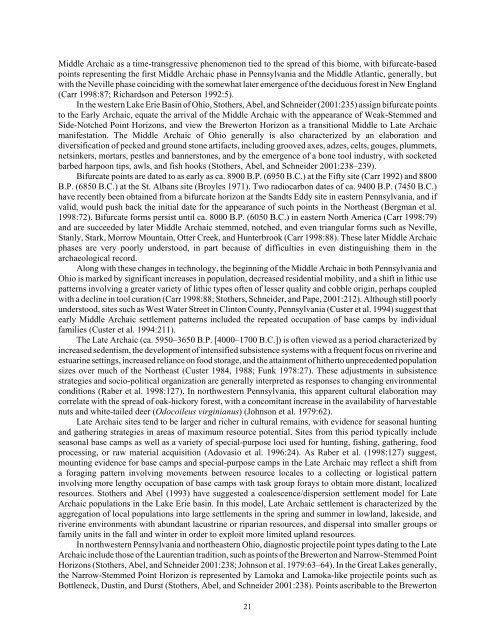Watershed Conservation Plan - Destination Erie
Watershed Conservation Plan - Destination Erie
Watershed Conservation Plan - Destination Erie
You also want an ePaper? Increase the reach of your titles
YUMPU automatically turns print PDFs into web optimized ePapers that Google loves.
Middle Archaic as a time-transgressive phenomenon tied to the spread of this biome, with bifurcate-based<br />
points representing the first Middle Archaic phase in Pennsylvania and the Middle Atlantic, generally, but<br />
with the Neville phase coinciding with the somewhat later emergence of the deciduous forest in New England<br />
(Carr 1998:87; Richardson and Peterson 1992:5).<br />
In the western Lake <strong>Erie</strong> Basin of Ohio, Stothers, Abel, and Schneider (2001:235) assign bifurcate points<br />
to the Early Archaic, equate the arrival of the Middle Archaic with the appearance of Weak-Stemmed and<br />
Side-Notched Point Horizons, and view the Brewerton Horizon as a transitional Middle to Late Archaic<br />
manifestation. The Middle Archaic of Ohio generally is also characterized by an elaboration and<br />
diversification of pecked and ground stone artifacts, including grooved axes, adzes, celts, gouges, plummets,<br />
netsinkers, mortars, pestles and bannerstones, and by the emergence of a bone tool industry, with socketed<br />
barbed harpoon tips, awls, and fish hooks (Stothers, Abel, and Schneider 2001:238–239).<br />
Bifurcate points are dated to as early as ca. 8900 B.P. (6950 B.C.) at the Fifty site (Carr 1992) and 8800<br />
B.P. (6850 B.C.) at the St. Albans site (Broyles 1971). Two radiocarbon dates of ca. 9400 B.P. (7450 B.C.)<br />
have recently been obtained from a bifurcate horizon at the Sandts Eddy site in eastern Pennsylvania, and if<br />
valid, would push back the initial date for the appearance of such points in the Northeast (Bergman et al.<br />
1998:72). Bifurcate forms persist until ca. 8000 B.P. (6050 B.C.) in eastern North America (Carr 1998:79)<br />
and are succeeded by later Middle Archaic stemmed, notched, and even triangular forms such as Neville,<br />
Stanly, Stark, Morrow Mountain, Otter Creek, and Hunterbrook (Carr 1998:88). These later Middle Archaic<br />
phases are very poorly understood, in part because of difficulties in even distinguishing them in the<br />
archaeological record.<br />
Along with these changes in technology, the beginning of the Middle Archaic in both Pennsylvania and<br />
Ohio is marked by significant increases in population, decreased residential mobility, and a shift in lithic use<br />
patterns involving a greater variety of lithic types often of lesser quality and cobble origin, perhaps coupled<br />
with a decline in tool curation (Carr 1998:88; Stothers, Schneider, and Pape, 2001:212). Although still poorly<br />
understood, sites such as West Water Street in Clinton County, Pennsylvania (Custer et al. 1994) suggest that<br />
early Middle Archaic settlement patterns included the repeated occupation of base camps by individual<br />
families (Custer et al. 1994:211).<br />
The Late Archaic (ca. 5950–3650 B.P. [4000–1700 B.C.]) is often viewed as a period characterized by<br />
increased sedentism, the development of intensified subsistence systems with a frequent focus on riverine and<br />
estuarine settings, increased reliance on food storage, and the attainment of hitherto unprecedented population<br />
sizes over much of the Northeast (Custer 1984, 1988; Funk 1978:27). These adjustments in subsistence<br />
strategies and socio-political organization are generally interpreted as responses to changing environmental<br />
conditions (Raber et al. 1998:127). In northwestern Pennsylvania, this apparent cultural elaboration may<br />
correlate with the spread of oak-hickory forest, with a concomitant increase in the availability of harvestable<br />
nuts and white-tailed deer (Odocoileus virginianus) (Johnson et al. 1979:62).<br />
Late Archaic sites tend to be larger and richer in cultural remains, with evidence for seasonal hunting<br />
and gathering strategies in areas of maximum resource potential. Sites from this period typically include<br />
seasonal base camps as well as a variety of special-purpose loci used for hunting, fishing, gathering, food<br />
processing, or raw material acquisition (Adovasio et al. 1996:24). As Raber et al. (1998:127) suggest,<br />
mounting evidence for base camps and special-purpose camps in the Late Archaic may reflect a shift from<br />
a foraging pattern involving movements between resource locales to a collecting or logistical pattern<br />
involving more lengthy occupation of base camps with task group forays to obtain more distant, localized<br />
resources. Stothers and Abel (1993) have suggested a coalescence/dispersion settlement model for Late<br />
Archaic populations in the Lake <strong>Erie</strong> basin. In this model, Late Archaic settlement is characterized by the<br />
aggregation of local populations into large settlements in the spring and summer in lowland, lakeside, and<br />
riverine environments with abundant lacustrine or riparian resources, and dispersal into smaller groups or<br />
family units in the fall and winter in order to exploit more limited upland resources.<br />
In northwestern Pennsylvania and northeastern Ohio, diagnostic projectile point types dating to the Late<br />
Archaic include those of the Laurentian tradition, such as points of the Brewerton and Narrow-Stemmed Point<br />
Horizons (Stothers, Abel, and Schneider 2001:238; Johnson et al. 1979:63–64). In the Great Lakes generally,<br />
the Narrow-Stemmed Point Horizon is represented by Lamoka and Lamoka-like projectile points such as<br />
Bottleneck, Dustin, and Durst (Stothers, Abel, and Schneider 2001:238). Points ascribable to the Brewerton<br />
21





